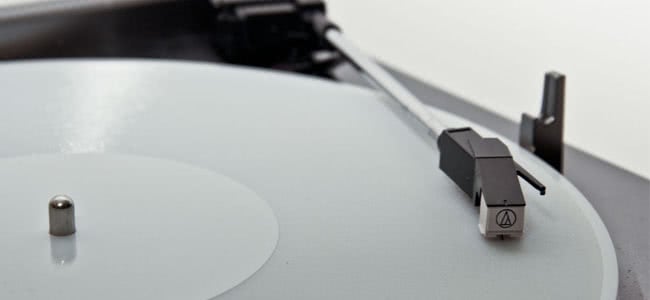3D Printing is already making waves across the manufacturing industry with the new technology potentially paving the way for cheaper methods of production and replication, and following on from introducing the world to the first 3D printed guitars, a music and technology boffin has now gifted the world the first 3D printed vinyl.
Along with researcher and Instructables DIY project site team member, Amanda Ghassaei can now potentially add ‘inventor’ to her roll call, having used 3D printing to enable a method that transforms a digital audio sample into a physical plastic record that plays on a standard turntable.
As Ghassaei writes on her website entry for the 3D Printed Record: “In order to explore the current limits of 3D printing technology, I’ve created a program for converting digital audio into a 3D model of a record and printed some functional prototypes that play on ordinary record players.”
While the audio quality is still sketchy, an introductory video shows that with a little bit of coding and tinkering with the Objet Connex500, an industrial line 3D Printer, a three dimensional model of a song’s audio waves can be printed as physical peaks and troughs, that just so happen to resemble the grooves of a vinyl record, onto a UV-cured resin. Or in the creator’s words: “It works by importing raw audio data, performing some calculations to generate the geometry of a record, and eventually exporting this geometry straight to a 3D printable file format.”
The video shows what the world’s first 3D printed record being played, featuring a gravelly, but nonetheless recognisable medley of Daft Punk’s ‘Around The World’, New Order’s ‘Blue Monday’, and Joy Division’s ‘Disorder’. As Ghassaei writes for the more technically minded, “the audio on the records is very low resolution, it has a sampling rate of 11kHz (a quarter of typical mp3 audio) and 5-6bit resolution (less than one thousandth of the resolution of typical 16 bit audio), but the result is easily recognisable.”
The grooves of the 3D record are shaped by extremely fine layers of plastic resin that are added in layers based on the blueprint of a digital model, such as those available on the Instructables website; the entire process demonstrating a new form of additive manufacturing, layering sheets in a 3D model built from the ground up rather than regular manufacturing that relies on cutting, shaping, and refining material – a subtractive process.
The new LP is one of many working prototypes that have sprung up in recent months, including a series of custom guitar bodies – including working electric and acoustic instruments in a variety of personalised designs – and, controversially, the world’s first working handgun (as Forbes reports). “It works by importing raw audio data, performing some calculations to generate the geometry of a record, and eventually exporting this geometry straight to a 3D printable file format.” – Amanda Ghassaei
The 3D record was made with an Objet Connex500 which has “incredibly high resolution: 600dpi in the x and y axes and 16 microns in the z axis, some of the highest resolution possible with 3D printing at the moment,” according to Ghassaei. But despite this fine detailing, the 3D printed records are still some ways from the resolution of a real vinyl record – thus the poor sound quality.
There are other limitations too, the 3D printing process only allows one side to be played and being cast onto a resin means they’re less flexible than vinyl records also (which could lead to a few more cracked LPs in packing and transit or simply tearing up a record’s needle), but it’s a dramatic first step to a personalised and potentially much more efficient form of record production.
Imagine being able to turn your own digital playlists into a physical vinyl ‘mixtape’ for a loved one? Or turning that bootlegged live audio into something you can chuck on the platter? DJs could conceivably create their own vinyl samples for use in their sets, or allowing bands to sell off the digital blueprints for a 3D records for fans to then print them from the comfort of their homes.
This leap in technology could, however, inadvertently lead to another mass form of music piracy. While very few can afford or have access to 3D printing technology, the aim is that they one day will soon be, and if people are able to use Ghassaei’s personalised code, which she has already made available on popular torrenting website the Pirate Bay, for their own use, the ‘drop in the ocean’ repercussions become pretty clear.
As a recent report from TechCrunch demonstrates, concerns over peer-to-peer networks for shared ‘physibles’ – the digital designs for 3D printed objects – have the potential to emerge online, demonstrating a new wave that echoes that of Napster and the mp3 boom, except this time it would be through the sharing of real-world physical objects, such as the aforementioned guitars and records.
Despite the more sinister implications, there’s no denying the exciting potential for Amanda Ghassaei’s breakthrough and it seems that it’s the first of a whole slew of experiments, with the Instructables creator now turning to laser cutting on other industrial formats to craft other vinyl-style records using a similar process to the 3D printing model – including Joy Division’s ‘Love Will Tear Us Apart’ on laser-cut acrylic, Radiohead’s ‘Idioteque’ on laser-cut wood, and Velvet Underground and Nico’s ‘Femme Fatale’ on laser-cut maple – which you can watch/hear below.

































